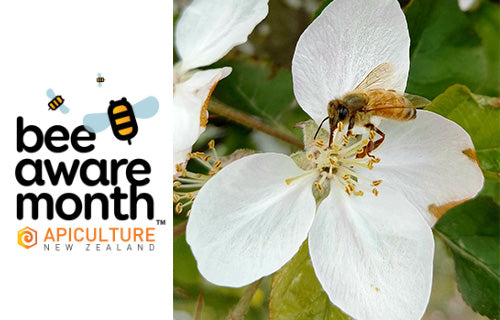Bee Aware Month - Feed the Bees

1 - 30 September is Bee Aware Month
For Bee Aware Month 2021, Apiculture New Zealand is asking people to ‘Feed the Bees’ by planting bee-friendly trees and plants.
Plants that bring all the bees to the yard
For bees, some plants are really worth buzzing about and others, not so much.
Unsurprisingly, the best bee plants produce lots of pollen and/or nectar and make these rewards easily accessible to pollinators. Plants that flower in autumn, and early spring are also bee favourites as they supply nectar and pollen when little else is available.
The Trees for Bees NZ team has been working for the last 10 years to identify what plants are best for our bees. Trees for Bees has produced regional, seasonal, urban and rural guides on what to plant for bees which are all available on its website (www.treesforbeesnz.org). Trees for Bees has identified some true star performers – those plants which have ‘a buzz’ about them, literally.
The first of these is rosemary, beloved by bees as it is almost always in flower especially in spring and autumn. Rosemary flowers are conveniently shaped for easy bee access with petals forming two ‘lips’. The lower lip makes a perfect bee landing platform, that the bee can hang onto while reaching inside to drink nectar. Trees for Bees notes that most Mediterranean herb plants, like rosemary, oregano and thyme, are excellent sources of nectar.
Pip fruit trees like apples, pears and quince produce masses of flowers filled with protein-packed pollen and plentiful nectar. The flowers of these trees have a bee-friendly ‘open dish’ shape, so bees can simply fly right in and get what they are looking for! Some plants have large ‘open dish’ flowers called super-bowl flowers including peonies, some camellias, and magnolias.
New Zealand flax (harakeke, korari and wharariki) produce pollen with the highest protein content of any plant studied by Trees for Bees so far. Flax has a tubular flower but it makes the pollen readily available to bees, by sticking its pollen-bearing anthers out beyond its petals. Flax flowers also make lots of nectar which is loved by birds, bumble bees, honey bees and native bees. Honey bees can reach this nectar if the tubular flower is ‘full’ but as the nectar level decreases, they sometimes can siphon nectar from between petals at the bottom of the tube. Other native plants loved by bees include cabbage trees, hebes and rengarenga.
Two species of lacebark (Hoheria populnea and H. sexstylosa) produce lots of pollen and nectar in autumn, a time when little else is available. These plants produce an abundance of ‘open dish’ star-shaped flowers which are perfectly suited to foraging bees.
Five finger (whauwhaupaku) flowers from mid-winter to early spring. The male trees have only male flowers offering both pollen and nectar to bees, and the female trees have female flowers producing nectar only. Female flowers have no petals, and when they exude nectar, they look like tiny toffee apples, a tasty treat for all nectar-loving garden dwellers especially birds that lick up the nectar!
For non-gardeners, there is an easy option to help our bees. Bees love weeds like clover and dandelions and while it’s never a good idea to plant pests, letting the weeds on your lawn flower from time to time will make your bees happy (and give you a break)!
Photo Credit: Nick Thorp
For more information visit www.apinz.org.nz/bee-aware-month-2021.
For a full list of our Bee Friendly products please see our Bee Series Collection.


Leave a comment
Also in Articles
Science Behind SeaMAX
February 20, 2024
Natural Anti-Inflammatory
February 20, 2024
SeaMAX: Mobility & Immunity Boost
February 20, 2024